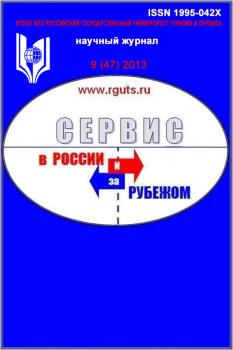Kazan, Russian Federation
Kazan, Russian Federation
Personal savings remain the one of the significant and stable sources of the longterm resource base of the banking sector organizations of any country. The demand for banking services among the population as owners of savings, according to economic laws, is in direct relationship and expands as the scale of industrial and exchange relations in the economy increases. Simultaneously, among the population there is also a certain set of factors that trigger the process of the inflow of savings into bank deposits. At the stages of economic growth and recession, the population forms the most active accumulations, but these processes are associated with different driving causes. The article gives an opinion on reducing the population's estimates of the factors determining the propensity to save in the Russian economy. In 2014-2015, the investment behavior of the Russian population was oriented to accumulation of savings that was associated with a significant deterioration in the economic situation and a lack of understanding about the future prospects of economic development. But today the model of investment behavior is gradual changing, and the growth rate of savings on banks' deposits has slowed significantly. The article draws conclusions about the significant investment potential of the Russian population. The authors characterize the trends in the individual savings behavior and the problems of attracting savings to the banking sector taking place in recent years in the Russian Feder-ation.
personal savings banking sector, individual investment behav-ior, savings model
1. Animica P.E. Osobennosti finansovogo povedeniya domashnih hozyaystv v usloviyah geo-politicheskoy nestabil'nosti // Izvestiya Ural'skogo gosudarstvennogo ekonomicheskogo universiteta. 2015. №4(60). S. 43-51.
2. Evstyunin E.V. Problemy investiciy i sberezheniy v rossiyskoy ekonomike // Molodezh' i nauka: sb. mat. H Yubileynoy Vseros. nauch.-tehn. konf. studentov, aspirantov i molodyh uchenyh. Krasnoyarsk: Sib. federal. un-t, 2014. URL: http://conf.sfu-kras.ru/sites/mn2014/directions.html (Data obrascheniya: 07.05.2017).
3. Portnov G.O. Vklady poshli na snizhenie // Kommersant. 27.04.2017. URL: https://www.kommersant.ru/doc/3283834 (Data obrascheniya: 07.05.2017).
4. Pyrkova G.H. Metody i mehanizmy osuschestvleniya investicionnoy bankovskoy deya-tel'nosti // Sovremennye aspekty ekonomiki. 2015. №6. S. 5-12.
5. Tegin M.S. Sberezheniya pereshli v nalichnye // Izvestiya. 14.03.2017. URL: http://izvestia.ru/news/670554 (Data obrascheniya: 07.05.2017).
6. Hmyz O.V. Bankovskiy sektor stran Central'noy i Vostochnoy Evropy posle krizisa // Bankovskoe delo. 2014. №4. S. 32-37.
7. Fedorova V.A. Sberezheniya naseleniya kak vazhnyy istochnik investicionnyh resursov v usloviyah antirossiyskih ekonomicheskih sankciy // Sborniki konferenciy NIC Socio-sfera. Praga: Vědecko vydavatelské centrum Sociosféra-CZ, 2015. №53. S. 224-226.
8. Yarasheva A.V., Aleksandrova O.A. Transformaciya investicionno-sberegatel'nogo pove-deniya vysokodohodnyh grupp naseleniya v period krizisa // Ekonomicheskie i social'-nye peremeny: fakty, tendencii, prognoz. 2016. №1(43). C. 122-135. DOI: 10/15838/esc/2016.1/43/8.
9. Cetorelli N., Mandel B.H., Mollineaux L. The Evolution of Banks and Financial Intermediation: Framing the Analysis // Economic Policy Review Federal Reserve Bank of New York. 2012. Vol. 18. №2. Pp. 1-12.
10. Deaton A. Franco Modigliani and the Life Cycle Theory of Consumption. Research Program in Development Studies and Center for Health and Wellbeing. Princeton University, 2005. 20 p.
11. Duesenberry J. Saving and Theory of Consumer Behavior. Cambridge, MA: Harvard University Press, 1952.
12. Fraczek B. The factors affecting the level of household savings and their influence on economy development. // 8th International scientific conference Financial management of firms and fi-nancial institutions VŠB-TU. Ostrava: Faculty of economics, finance department, 2011. 6 p.
13. Kaigorodova G.N., Mustafina A.A. The influence of forms of insurance coverage organization on population's life quality // Mediterranean Journal of Social Sciences. 2014. Vol.5. Pp. 118-123. DOI:https://doi.org/10.5901/mjss.2014.v5n24p118.
14. Richard A. Werner Can banks individually create money out of nothing? The theories and the empirical evidence // International Review of Financial Analysis. 2014. Vol.36. Pp. 1-19. DOI:https://doi.org/10.1016/j.irfa.2014.07.015.





